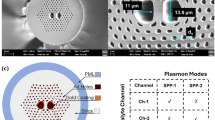Abstract
A long range surface plasmon (LRSP) is an electromagnetic wave propagating along a thin metal film with an order of magnitude lower damping than conventional surface plasmon (SP) waves. Thus, the excitation of LRSP is associated with a narrower resonance and it provides larger enhancement of intensity of the electromagnetic field. In surface plasmon resonance (SPR) biosensors, these features allow a more precise observation of the binding of biomolecules in the proximity to the metal surface by using the (label-free) measurement of refractive index (RI) variations and by SP-enhanced fluorescence spectroscopy. In this contribution, we investigate LRSPs excited on a layer structure consisting of a fluoropolymer buffer layer, a thin gold film, and an aqueous sample. By implementing such structure in an SPR sensor, we achieved a 2.4- and 4.4-fold improvement of the resolution in the label-free and fluorescence-based detection, respectively, of the binding of biomolecules in the close proximity to the surface. Moreover, we demonstrate that the sensor resolution can be improved by a factor of 14 and 12 for the label-free and fluorescence-based detection, respectively, if the biomolecular binding events occur within the whole evanescent field of LRSP.










Similar content being viewed by others
References
Rather H (1983) Surface plasmons on smooth and rough surfaces and on gratings. Springer, Berlin Heidelberg New York
Homola J, Yee SS, Gauglitz G (1999) Surface plasmon resonance sensors: review. Sens Actuators, B, Chem 54:3–15
Liebermann T, Knoll W (2000) Surface-plasmon field-enhanced fluorescence spectroscopy. Colloids Surf, A Physicochem Eng Asp 171:115–130
Sarid D (1981) Long-range surface-plasma waves on very thin metal-films. Phys Rev Lett 47:1927–1930
Craig AE, Olson GA, Sarid D (1983) Experimental observation of the long-range surface-plasmon polariton. Opt Lett 8:380–382
Matsubara K, Kawata S, Minami S (1990) Multilayer system for a high-precision surface-plasmon resonance sensor. Opt Lett 15:75–77
Nenninger GG, Tobiska P, Homola J, Yee SS (2001) Long–range surface plasmons for high–resolution surface plasmon resonance sensors, Sensors and Actuators B–Chemical 74:145–151
Slavik S, Homola J (2007) Ultrahigh resolution long range surface plasmon-based sensor. Sens Actuators, B, Chem 123:10–12
Wark AW, Lee HJ, Corn RM (2005) Long-range surface plasmon resonance imaging for bioaffinity sensors. Anal Chem 77:3904–3907
Kasry A, Knoll W (2006) Long range surface plasmon fluorescence spectroscopy. Appl Phys Lett 89:101106
Knoll W, Zizlsperger M, Liebermann T, Arnold S, Badia A, Liley M, Piscevic D, Schmitt FJ, Spinke J (2000) Streptavidin arrays as supramolecular architectures in surface-plasmon optical sensor formats. Colloids Surf, A Physicochem Eng Asp 161:115–137
Swann MJ, Peel LL, Carrington S, Freeman NJ (2004) Dual-polarization interferometry: an analytical technique to measure changes in protein structure in real time, to determine the stoichiometry of binding events, and to differentiate between specific and nonspecific interactions. Anal Biochem 329:190–198
Malmsten M (1994) Ellipsometry studies of protein layers adsorbed at hydrophobic surfaces. J Colloid Interface Sci 166:333–342
Homola J, Piliarik M (2006) SPR sensor instrumentation. In: Homola J (ed) Surface plasmon resonance based sensors. Springer, Berlin Heidelberg New York, pp 45–69
Vasilev K, Knoll W, Kreiter M (2004) Fluorescence intensities of chromophores in front of a thin metal film. J Chem Phys 120:3439–3445
Acknowledgements
Partial support for this work was provided by the Deutsche Forschungsgemainschaft (KN 224/18-1, Schwerpunktprogramm “Intelligente Hydrogele”, JPP 1259) and by the EU through FP6-2005-FOOD-036300 (“TRACEPACK”).
Author information
Authors and Affiliations
Corresponding author
Rights and permissions
About this article
Cite this article
Dostálek, J., Kasry, A. & Knoll, W. Long Range Surface Plasmons for Observation of Biomolecular Binding Events at Metallic Surfaces. Plasmonics 2, 97–106 (2007). https://doi.org/10.1007/s11468-007-9037-8
Received:
Accepted:
Published:
Issue Date:
DOI: https://doi.org/10.1007/s11468-007-9037-8




